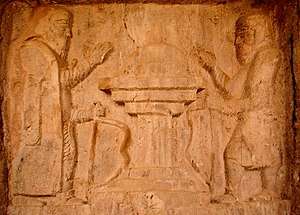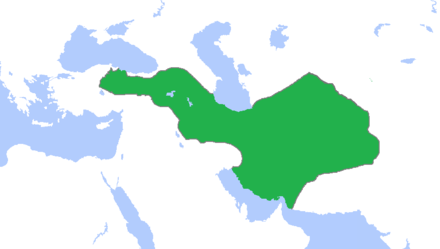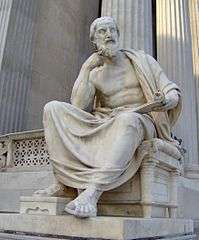Cyaxares
Cyaxares (Ancient Greek: Κυαξάρης; Old Persian: 𐎢𐎺𐎧𐏁𐎫𐎼 Uvaxštra;[3][4] Avestan: Huxšaθra "Good Ruler"; Akkadian: Umakištar;[5] Old Phrygian: ksuwaksaros;[6] r. 625–585 BC) was the third and most capable king of Media, according to Herodotus, with a far greater military reputation than his father Phraortes or grandfather Deioces. He was the first to divide his troops into separate sections of spearmen, archers, and horsemen.[7]
| Cyaxares | |
|---|---|
| King of Media | |
 | |
| Reign | 625–585 BC |
| Predecessor | Phraortes |
| Successor | Astyages |
| Born | Ecbatana (present-day Hamadan) |
| Burial | Syromedia (present-day Qyzqapan), according to Igor Diakonov[2] |
| Spouse | Daughter (or granddaughter) of Nabopolassar |
| Issue | Astyages Amytis (or granddaughter) |
| Dynasty | Median Dynasty |
| Father | Phraortes |
| Religion | Ancient Iranian religion |
By uniting most of the Iranian tribes of ancient Iran and conquering neighbouring territories, Cyaxares transformed the Median Empire into a regional power.[8] He facilitated the fall of the Neo-Assyrian Empire, and according to Herodotus repelled the Scythians from Media.[9]
The rise of Cyaxares

Cyaxares was born in the Median capital of Ecbatana. His father Phraortes was killed in a battle against the Assyrians, led by Ashurbanipal, the king of Assyria. After Phraortes' demise, the Scythians overran Media and controlled the area for a period of twenty-eight years.[10] Cyaxares, seeking revenge, killed the Scythian leaders[11] and proclaimed himself King of Medes. After throwing off the Scythians, he prepared for war against Assyria.[12] Cyaxares reorganized the Median army, then allied himself with King Nabopolassar of Babylonia, a mutual enemy of Assyria. This alliance was formalized through the marriage of Cyaxares' daughter, Amytis, to Nabopolassar's son, Nebuchadnezzar II. Cyaxares also allied with the Scythians even though they warred against each other a decade earlier.[13] In the year 612 B.C.E, Cyaxares and his army was able to conquer Assur and he also claimed the Assyrian capital of Nineveh. The Medians, Babylonians, and Scythians overthrew the Assyrian Empire and destroyed Nineveh in 612 BC. Fighting between the Medes and the Assyrians would finally come to an end in the year 609 B.C.E.
War against Lydia


After the victory in Assyria, the Medes conquered Northern Mesopotamia, Armenia and the parts of Asia Minor east of the Halys River, which was the border established with Lydia after a decisive battle between Lydia and Media, the Battle of Halys ended with an eclipse on May 28, 585 BC. Before Cyaxares was confronted with the threat of the Lydian army, Alyattes had previously campaigned in the eastern regions of Phrygia and Gordion.[14]
The conflict between Lydia and the Medes was reported by Herodotus as follows:
- "A horde of the nomad Scythians at feud with the rest withdrew and sought refuge in the land of the Medes: and at this time the ruler of the Medes was Cyaxares the son of Phraortes, the son of Deïokes, who at first dealt well with these Scythians, being suppliants for his protection; and esteeming them very highly he delivered boys to them to learn their speech and the art of shooting with the bow. Then time went by, and the Scythians used to go out continually to the chase and always brought back something; till once it happened that they took nothing, and when they returned with empty hands Cyaxares (being, as he showed on this occasion, not of an eminently good disposition) dealt with them very harshly and used insult towards them. And they, when they had received this treatment from Cyaxares, considering that they had suffered indignity, planned to kill and to cut up one of the boys who were being instructed among them, and having dressed his flesh as they had been wont to dress the wild animals, to bear it to Cyaxares and give it to him, pretending that it was game taken in hunting; and when they had given it, their design was to make their way as quickly as possible to Alyattes the son of Sadyattes at Sardis. This then was done; and Cyaxares with the guests who ate at his table tasted of that meat, and the Scythians having so done became suppliants for the protection of Alyattes.
- After this, since Alyattes would not give up the Scythians when Cyaxares demanded them, there had arisen war between the Lydians and the Medes lasting five years; in which years the Medes often discomfited the Lydians and the Lydians often discomfited the Medes (and among others they fought also a battle by night): and as they still carried on the war with equally balanced fortune, in the sixth year a battle took place in which it happened, when the fight had begun, that suddenly the day became night. And this change of the day Thales the Milesian had foretold to the Ionians laying down as a limit this very year in which the change took place. The Lydians however and the Medes, when they saw that it had become night instead of day, ceased from their fighting and were much more eager both of them that peace should be made between them. And they who brought about the peace between them were Syennesis the Kilikian and Labynetos the Babylonian: these were they who urged also the taking of the oath by them, and they brought about an interchange of marriages; for they decided that Alyattes should give his daughter Aryenis to Astyages the son of Cyaxares, since without the compulsion of a strong tie agreements are apt not to hold strongly together." (The Histories, 1.73-74, trans. Macaulay) After the subsequent interchange of marriage, fighting ceased between the Medians and the Lydians, yet Croesus would later refuse to send aid to Astyages when faced with conflict from Cyrus the Great.[14] Thus showing that while the resulting marriages may have prevented more fighting between the Medians and the Lydians, the two kingdoms were not joined in any type of alliance.
 Halys River
Halys River
Cyaxares died shortly after the battle and was succeeded by his son, Astyages, who was the maternal grandfather of Cyrus the Great through his daughter Mandane of Media.
Qyzqapan
Qyzqapan is a tomb located in the mountains of Iraqi Kurdistan in Sulaymaniyah. The Russian historian Igor Diakonov believed that it is probably a royal tomb and that if it is royal it is the tomb of Cyaxares.[2]
Legacy
In later accounts of the Hanging Gardens of Babylon, this was remembered as Nebuchadrezzar's present for his wife Amytis Cyaxares's daughter, to help with her homesickness for the mountainous country of her birth.[15]
After Darius I seized the Iranshahr, rebellions erupted claiming Uvaxštra's legacy. After these were defeated, the shah noted two in the Behistun Inscription: "Another was Phraortes [Fravartiš], the Mede [Mâda]; he lied, saying: 'I am Khshathrita, of the dynasty of Cyaxares.' He made Media to revolt. Another was Tritantaechmes [Ciçataxma], the Sagartian [Asagartiya]; he lied, saying: 'I am king in Sagartia, of the dynasty of Cyaxares.' He made Sagartia to revolt."
See also
- History of Iran
- Iranian Peoples
- Cyaxares II
- Medes
- Eclipse of Thales
References
- Gershevitch, I.; Fisher, William Bayne; Avery, Peter; Boyle, John Andrew; Frye, Richard Nelson; Yarshater, Ehsan; Jackson, Peter; Melville, Charles Peter; Lockhart, Laurence; Hambly, Gavin (1985). The Cambridge History of Iran. Cambridge University Press. p. 139. ISBN 9780521200912.
- Gershevitch, Ilya (1984). The Cambridge history of Iran: The Median and Achaemenian periods.
- Akbarzadeh, D.; A. Yahyanezhad (2006). The Behistun Inscriptions (Old Persian Texts) (in Persian). Khaneye-Farhikhtagan-e Honarhaye Sonati. p. 87. ISBN 964-8499-05-5.
- Kent, Ronald Grubb (1384 AP). Old Persian: Grammar, Text, Glossary (in Persian). translated into Persian by S. Oryan. p. 406. ISBN 964-421-045-X. Check date values in:
|year=(help) - https://www.livius.org/articles/person/cyaxares/
- Diakonoff 1993, pp. 478-479.
- Herodotus (425 BC). The Histories (2008 ed.). Oxford University Press. pp. 48. Check date values in:
|date=(help) - http://global.britannica.com/EBchecked/topic/147792/Cyaxares
- Cyaxares (Livius.org)
- Middleton, John (2015). "World Monarchies and Dynasties". EBSCOhost. Retrieved 2019-04-28.
- Grousset, Rene (1970). The Empire of the Steppes. Rutgers University Press. pp. 8–9. ISBN 0-8135-1304-9.
- Gershevitch, Ilya (1984). The Cambridge history of Iran: The Median and Achaemenian periods.
- Middleton, John. "World Monarchies and Dynasties". EBSCOhost. Armonk, N.Y. ; Great Britain. Retrieved 2019-02-28.
- Leloux, Kevin. "The Battle of the Eclipse". https://orbi.uliege.be/. Polemos. Retrieved 2019-04-30. External link in
|website=(help) - Dalley, Stephanie (2013). The Mystery of the Hanging Garden of Babylon: an elusive World Wonder traced. Oxford University Press. ISBN 978-0-19-966226-5.
Sources
| Wikisource has the text of the 1911 Encyclopædia Britannica article Cyaxares. |
- Diakonoff, I. M. (1993). "CYAXARES". Encyclopaedia Iranica, Vol. VI, Fasc. 5. pp. 478–479.CS1 maint: ref=harv (link)
External links
| Wikimedia Commons has media related to Qyzqapan. |
| Preceded by Madius |
King of Medes | Succeeded by Astyages |